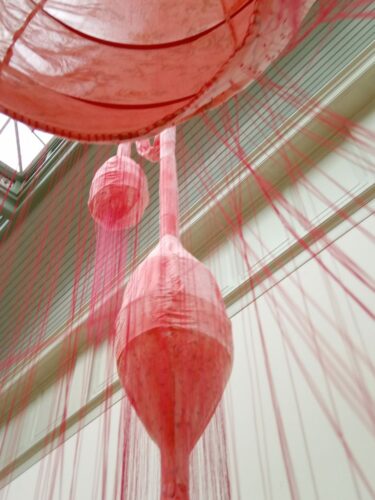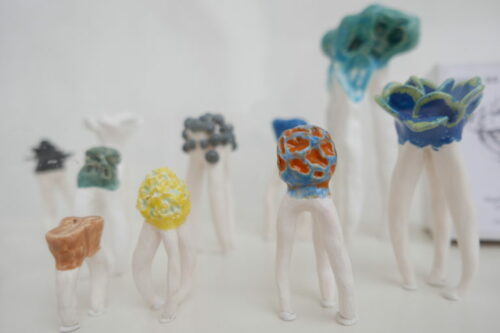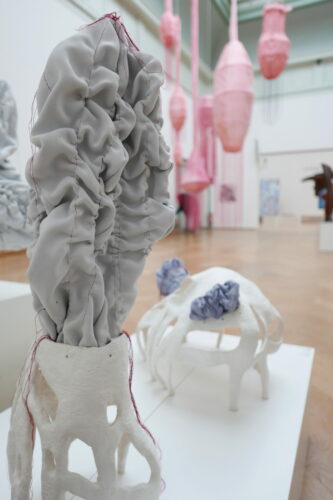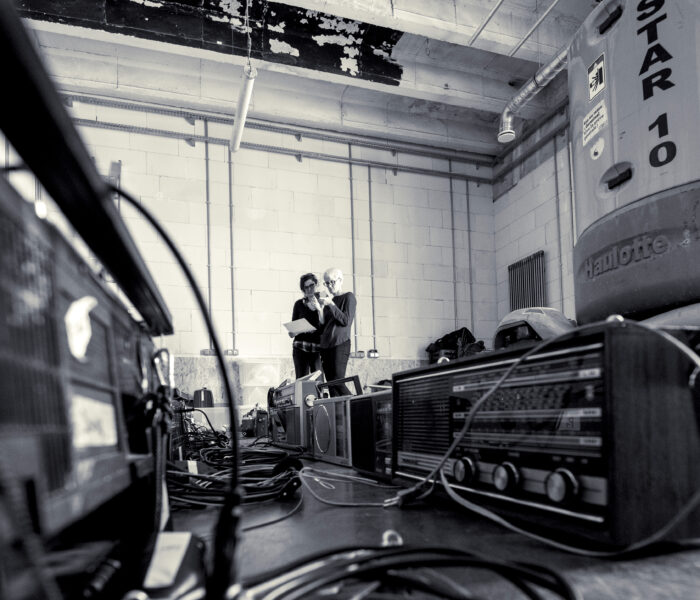Il est à Nantes un lieu singulier où la scène prend différentes formes, différents sens, en marge des approches académiques. Au Studio d’en haut, des artistes aux univers variés et singuliers trouvent un espace de liberté pour élaborer leurs projets. Rencontre avec Rasim Biyikli et Anthony Taillard, inventeurs de ce lieu où règne l’esprit d’ouverture.
« On a eu la chance de commencer à un moment où il était encore possible de s’inventer soi-même, d’inventer son endroit, se souvient Rasim Biyikli. Depuis 2008, le Studio d’en haut est un Léviathan, sa forme n’est pas fixe, pas précisée. C’est un espace de production qui accueille des projets qui ne correspondent pas à ce qu’on attend. Tout projet parallèle, difficile, complexe, qui demande de la recherche peut nous intéresser. Il y a peu, nous discutions avec un ancien de la Drac des aides à la maquette, à la recherche, si importantes pour toute démarche artistique, mais surtout pour les musiques expérimentales. Eh bien elles n’existent plus ! »
Pépinière, refuge et laboratoire
Aux artistes qui aimeraient proposer un projet au Studio d’en haut, Anthony Taillard répond simplement : « Il n’y a pas de sélection ! Des propositions arrivent, c’est tout. » Rasim est le pianiste du groupe Orange Blossom, qui mêle, depuis 1993 musiques du monde et électro. Guitariste rock et jazz, Anthony est passionné par la musique dronique et les nouvelles lutheries. Les deux amis ont cofondé le studio dans l’idée, au départ, de pouvoir gérer leurs propres activités musicales, « pour être autonomes et indépendants, poursuit Anthony. Puis, des amis musiciens se sont agrégés au lieu. » Comme le percussionniste australien Will Guthrie, Nantais d’adoption, qui rejoint le projet en 2012. L’indépendance du Studio d’en haut lui a plu : « J’avais envie d’organiser mes projets d’une autre manière que ce qu’on fait dans le cadre institutionnel. Ma musique ne rentrait pas dans les cases des projets subventionnés. La démarche du Studio d’en haut ressemble davantage à la façon dont les artistes mènent leurs projets chez moi, en Australie : avec beaucoup moins de soutiens financiers, l’énergie investie n’est pas du tout la même, l’implication personnelle, artistique, est bien plus grande. »
« Tous les artistes qui passent chez nous ont un esprit d’ouverture et non de conquête, insiste Rasim. On défend une production qui propose des projets nouveaux avec des artistes qui veulent donner de leur corps et de leur cœur, en espérant que le public accepte cela. On sent beaucoup que la tendance est à caresser le public dans le sens du poil, très peu de le faire sortir de sa zone de confort. » Le Studio d’en haut est producteur, pas distributeur. Or, la diffusion est parfois difficile : « Nous ne rentrons pas dans les cases attendues, poursuit Rasim. Ce qui est dommageable pour la diversité artistique. »
La liste des artistes qui ont travaillé et travaillent avec le Studio d’en haut est longue et variée : citons, parmi eux, Thomas Tilly, Pierrick Sorin, Christophe Havard, mais l’ensemble 0, Gaspar Claus ou encore Sylvain Chauveau…
Le Studio d'en Haut – 2022 from Le Studio d'en Haut on Vimeo.
Immersif à la sauce Studio d’en haut
« Immersif » est sans aucun doute le mot à la mode. « Concerts immersifs », « participatifs », « expériences »… Les programmateurs sont friands de ces termes. Ces nouveaux dispositifs destinés à élargir l’accès au concert interrogent Rasim et Anthony. « On a monté nous aussi un dispositif immersif, avec l’artiste Nguyen Le Hoang, c’est Double Je. Mais la notion d’immersif y est bien loin de tout ce qui est à la mode : les casques 3D etc. qui, selon nous, mettent des œillères. Nous n’en sommes pas friands. Notre envie est de proposer quelque-chose d’immersif ET de collaboratif », explique Rasim. Concrètement, le spectateur se retrouve au centre des quatre enceintes, face à une projection vidéo : un intérieur de salon. Des accessoires sont disposés ici et là : quelques livres sur une étagère, un cadre photo sur la table, des jouets d’enfants sur le tapis. La lumière, changeante, offre une multiplicité de points de vue et des personnages apparaissent en image ou en voix. On écoute les ambiances, le bruitage, les voix, les respirations, les soupirs. La musique s’ajoute à cela, titillant l’imagination.
Les musiques expérimentales redéfinissent le rapport à la scène
Mais l’immersion née aussi sur scène, pas seulement grâce à des dispositifs numériques. Will Guthrie revient d’une tournée en Scandinavie avec son ensemble de gamelans Nist Nah. « Anthony m’a proposé de monter un projet avec le soutien du Studio d’en haut et de la salle nantaise La Soufflerie. Je voulais travailler avec les gamelans javanais depuis longtemps ; j’ai étudié cet instrument fascinant en Australie, pendant mes études au conservatoire. Je n’osais pas… Je ne me sentais pas légitime, je ne suis pas indonésien, ce n’est pas ma culture. » Pour Will, le concert a une vocation : la connexion à la musique, qui dirige, à elle seule, la performance. La mode des « nouvelles formes de concert » le fait sourire. « Nous faisons des concerts immersifs depuis très longtemps, dans les musiques expérimentales ! Depuis 20 ans, je joue mes solos au milieu de la pièce et des gens, cette idée d’être sur scène avec le public en face est dépassée depuis longtemps. Jouer sur scène, loin du public, n’est pas satisfaisant. Les musiques expérimentales redéfinissent sans cesse le rapport à la scène, de manière intuitive, sans même se poser la question. »
Filmer, enregistrer, motoriser, improviser
Anthony est quant à lui à l’origine d’un projet détonnant, en trois volumes, à la fois visuel et sonore, c’est « Immensity of the Territory ». L’idée est un peu folle : fasciné par l’esprit des road movies américains, le guitariste a mixé des phonographies collectées au cours de trois voyages aux Etats-Unis et au Canada avec des guitares électriques. Certaines sont augmentées de dispositifs motorisés qui sont contrôlés à distance ! « Le projet est sorti au disque, mais il existe aussi sur scène : notre trio joue et compose la musique en direct pendant que nous projetons les films que nous avons tourné en Amérique. » Les deux premiers spectacles faisaient référence aux westerns, aux road movies et à la Nouvelle vague. Le dernier opus plonge l’auditeur dans les explorations pionnières le long du Missouri, dans les grands espaces du Montana, les sites industriels qui bordent le Michigan et les forêts canadiennes
Concert ou installation ? À la croisée des chemins
Plus récemment, Rasim et Anthony ont remis leurs casquettes d’inventeurs et imaginé « Dédale », autre projet singulier qui rebat les cartes du concert tel qu’on l’imagine : l’expérience est au croisement de l’installation sonore et d’un concert dans la forme changerait perpétuellement. Un piano préparé, une guitare électrique, un orgue à lecteur de disquettes et d’autres prototypes un peu fous se rencontrent. Les deux artistes commandent à distance ces instruments robotisés pour composer, en direct, une symphonie. « L’expérience ‘Dédale’ peut se vivre seul ou avec public », précise Anthony.
Et l’expérimentation continue. Le Studio d’en haut prépare une collaboration avec la plasticienne Sophie Papiau. « Nous aimerions sonoriser les sculptures en textil et céramiques qu’elle a réalisé pour l’exposition Pink Forest . » Il est ainsi à Nantes un lieu singulier où s’inventent de nouvelles expériences sonores et musicales, portées par des artistes convaincus qu’on peut, aujourd’hui, aller chercher le public là où il ne s’y attend pas pour l’emmener vers des ailleurs plus que jamais revigorants.



Suzanne Gervais



)



